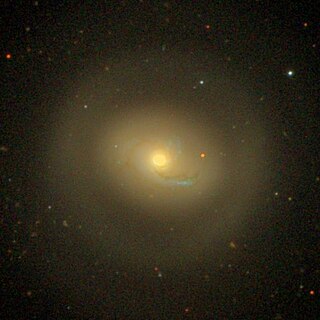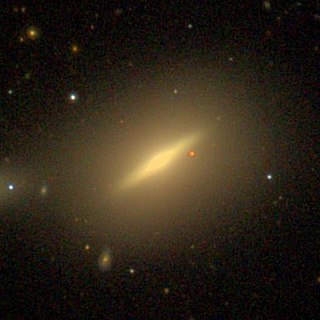
The Norma Cluster (ACO 3627 or Abell 3627) is a rich cluster of galaxies located near the center of the Great Attractor; it is about 68 Mpc (222 Mly) distant. Although it is both nearby and bright, it is difficult to observe because it is located in the Zone of Avoidance, a region near the plane of the Milky Way. Consequently, the cluster is severely obscured by interstellar dust at optical wavelengths. Its mass is estimated to be on the order of 1015 solar masses.

NGC 2207 and IC 2163 are a pair of colliding spiral galaxies about 80 million light-years away in the constellation Canis Major. Both galaxies were discovered by John Herschel in 1835.

Abell 400 is a galaxy cluster which contains the galaxy NGC 1128 with two supermassive black holes spiraling towards merger.

The Hydra Cluster is a galaxy cluster that contains 157 bright galaxies, appearing in the constellation Hydra. The cluster spans about ten million light-years and has an unusually high proportion of dark matter. The cluster is part of the Hydra–Centaurus Supercluster located 158 million light-years from Earth. The cluster's largest galaxies are elliptical galaxies NGC 3309 and NGC 3311 and the spiral galaxy NGC 3312 all having a diameter of about 150,000 light-years. In spite of a nearly circular appearance on the sky, there is evidence in the galaxy velocities for a clumpy, three-dimensional distribution.

IC 755, also known as NGC 4019, is a barred spiral galaxy. It lies about 60 million light-years away in the northern constellation of Coma Berenices. It is a member of the Virgo Cluster.

Abell 2199 is a galaxy cluster in the Abell catalogue featuring the brightest cluster galaxy NGC 6166, a cD galaxy. Abell 2199 is the definition of a Bautz-Morgan type I cluster due to NGC 6166.
Abell 133 is a galaxy cluster in the Abell catalogue.

Abell 262 is a galaxy cluster in the Abell catalogue. It is part of the Perseus–Pisces Supercluster, one of the largest known structures in the universe. Although its central galaxy, NGC 708, is a giant cD galaxy, most of its bright galaxies are spirals, which is unusual for a galaxy cluster. With approximately 200 members it is a comparatively small cluster.

NGC 2082 is an intermediate spiral galaxy in the Dorado constellation. It was originally thought to be part of the Dorado Group of galaxies, but was later removed. It was discovered on November 30, 1834 by John Herschel.

NGC 4457 is an intermediate spiral galaxy located about 55 million light-years away in the constellation of Virgo. It is also classified as a LINER galaxy, a class of active galaxy defined by their spectral line emissions. NGC 4457 Is inclined by about 33°. It was discovered by astronomer William Herschel on February 23, 1784. Despite being listed in the Virgo Cluster Catalog as VCC 1145, NGC 4457 is a member of the Virgo II Groups which form an extension of the Virgo cluster.

NGC 4638 is an edge-on lenticular galaxy located about 50 million light-years away in the constellation Virgo. NGC 4638 was discovered by astronomer William Herschel on March 15, 1784. The galaxy is a member of the Virgo Cluster.

NGC 3861 is a large barred spiral galaxy with a ring-like structure located about 310 million light-years away in the constellation Leo. It was discovered by astronomer John Herschel on March 23, 1827. NGC 3861 is a member of the Leo Cluster and has a normal amount of neutral hydrogen and ionised hydrogen.

NGC 703 is a lenticular galaxy located 240 million light-years away in the constellation Andromeda. The galaxy was discovered by astronomer William Herschel on September 21, 1786 and is also a member of Abell 262.

NGC 709 is a lenticular galaxy located 150 million light-years away in the constellation Andromeda. It was discovered by the Irish engineer and astronomer Bindon Blood Stoney on October 28, 1850 and is a member of the galaxy cluster Abell 262.

NGC 710 is a spiral galaxy located 260 million light-years away in the constellation Andromeda. It was discovered by the Irish engineer and astronomer Bindon Blood Stoney on October 28, 1850 and is a member of the galaxy cluster Abell 262.

NGC 753 is a spiral galaxy located 220 million light-years away in the constellation Andromeda. The galaxy was discovered by astronomer by Heinrich d'Arrest on September 16, 1865 and is a member of Abell 262.

NGC 759 is an elliptical galaxy located 230 million light-years away in the constellation Andromeda. NGC 759 was discovered by astronomer by Heinrich d'Arrest on September 17, 1865. It is a member of Abell 262.

NGC 4076 is a spiral galaxy located 290 million light-years away in the constellation Coma Berenices. The galaxy was discovered by astronomer William Herschel on April 27, 1785 and is a member of the NGC 4065 Group.

NGC 4098 is an interacting pair of spiral galaxies located 330 million light-years away in the constellation Coma Berenices. NGC 4098 was discovered by astronomer William Herschel on April 26, 1785. It was then rediscovered by Hershel on December 27, 1786 was listed as NGC 4099. NGC 4098 is a member of the NGC 4065 Group.

NGC 918 is a barred spiral galaxy in the constellation Aries about 67 million light years from the Milky Way. It was discovered by John Herschel on Jan 11, 1831.



















